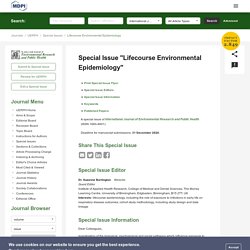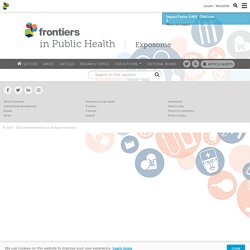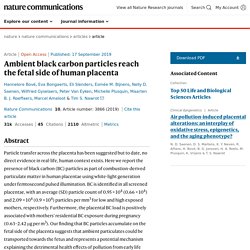

The Human Exposome Project. Special Issue : Lifecourse Environmental Epidemiology. Special Issue Editor Dr.

Suzanne BartingtonWebsiteGuest Editor Institute of Applied Health Research, College of Medical and Dental Sciences, The Murray Learning Centre, University of Birmingham, Edgbaston, Birmingham, B15 2TT, UKInterests: lifecourse epidemiology, including the role of exposure to infections in early life on respiratory disease outcomes; cohort study methodology, including study design and data linkage Special Issue Information Dear Colleagues, Investigation of the biological, psychological and social pathways which influence exposure to environmental factors and associated health risks is gaining significant traction as a focus for interdisciplinary environmental epidemiology research. Development of exposome correlation globes to map out environment-wide associations - PubMed. The environment plays a major role in influencing diseases and health.

The phenomenon of environmental exposure is complex and humans are not exposed to one or a handful factors but potentially hundreds factors throughout their lives. The exposome, the totality of exposures encountered from birth, is hypothesized to consist of multiple inter-dependencies, or correlations, between individual exposures. These correlations may reflect how individuals are exposed. Currently, we lack methods to comprehensively identify robust and replicated correlations between environmental exposures of the exposome.
Further, we have not mapped how exposures associated with disease identified by environment-wide association studies (EWAS) are correlated with other exposures. The exposome: When our environment drives health and disease. Science, has published in its January issue two papers by Associate Prof.

Emma Schymanski, Head of the Environmental Cheminformatics research group at the University of Luxembourg. In the two contributions to Science, Prof. Schymanski and her co-authors present the exposome, a recent concept aiming to capture the diversity of environmental factors that can affect us. They also summarise new technological advances and analytical tools used to identify chemicals and understand their impact. What's happening to your brain under lockdown? - ABC News. Doctor's Note: Coronavirus and the toll on mental health.
Frontiers in Public Health. Our mission is to create a major open access resource for professionals from diverse disciplines interested in the development of the concept of exposome and in its applications to public health.

When introduced in 2005, the notion of exposome was intended to encompass all the environmental exposures that individuals and populations may experience. It was proposed to complement the strong development of our knowledge about the genome and balance the effort to comprehend the role of the genome in human disease. ScienceDirect Topics. Characterizing the Exposome Although characterizing the exposome as defined above is a daunting challenge that may never be fully achieved, strategies and methods can be developed for getting ‘snapshots’ of important portions of the exposome at different times.

To achieve this goal, first choose between ‘bottom-up’ and ‘top-down’ exposomic strategies. A bottom-up strategy involves sampling of air, water, and dietary sources of exposure, followed by quantitation of all potential analytes and represents an exposomic approach to external exposure assessment. This would require developing many new sensors of external environmental exposures but would miss essential components of the internal chemical environment; for example, contributions from the microbiome, infection, inflammation, and stress. In contrast, a top-down exposomic strategy would employ biological monitoring of subjects, most likely via blood sampling or use of archived blood specimens.
The Exposome Turns 10. [+]Enlarge Credit: Shutterstock/C&EN The exposome is defined as the sum of an individual’s environmental exposures, including chemicals, food, and even stress, over the course of a lifetime.

“Omes” are all the rage these days. The genome, the proteome, the metabolome—they’ve been dominating the scientific scene. Your Exposome Is The Sum Of Every Place You've Ever Been. Do you have a dog?

With a simple test, Dean Jones, professor of medicine at Emory University, says he can peg a pet owner. “We can pretty much guess who has pets based upon what’s in their blood,” he says. That's because an egg-killing chemical used in tick and flea collars also makes its way into owners’ systems. That’s as far as the information goes at this point, though. Are these chemicals dangerous? Tox21 - Toxicology in the 21st Century. The Tox21 Consortium - Home. Basel Convention Home Page. Rotterdam Convention Home Page. Stockholm Convention - Home page. ChemicalWatch. Infants exposed to air pollution have less lung power as adolescents – study. Infants exposed to even low levels of air pollution experience reduced lung function as children and teenagers, researchers have found.

Their study found that exposure to air pollution in the first year of life reduced lung function development from the ages of six to 15, even at pollution levels below EU standards. Ambient black carbon particles reach the fetal side of human placenta. Study population and sample collection and preparation The present study on term placentae is executed within the framework of the ENVIRONAGE (ENVIRonmental influence ON AGEing in early life) birth cohort32.

Special Issue : The Environment and Children’s Health. Dr.

Jason GillilandWebsiteGuest Editor Human Environments Analysis Laboratory, Department of Geography, Western University, 1151 Richmond St, London, ON N6A 3K7, CanadaInterests: children’s health; children’s geographies; built environment; social environment; nature; health behaviours; mental health; well-being Dr. Handling “wicked” environmental hazards and the risk to health - Oxford Medicine. Assessing and responding to the health impacts of environmental pollution By Dr Alex Stewart Image credit: Pollution by Petter Rudwall. CC0 Public Domain via Unsplash. MedEdPublish - Wicked Problems in Health Professions Education: Adaptive Action in Action. Bak, P. (1996) How Nature Works: The science of self-organized criticality.
New York: Springer-Verlag. Bates Evoy, S. (2016) Open Space Technology: An effective tool for consultation. The Visionary Practitioner: Learning from the Research. Effective_tool_for_consultation (Accessed: 6 December 2019). Baxley, B. Special Issue : Global Health: An Unique and Comprehensive Perspective. Dear Colleagues, We would like to invite you to send contributions to the special issue of IJERHP entitled “Global Health: A Unique and Comprehensive Perspective”. The WHO defines the One Health concept as “… an approach to designing and implementing programmes, policies, legislation and research in which multiple sectors communicate and work together to achieve better public health outcomes”. It is now recognized worldwide that the multiple links between the life and the conditions of humans, animals, plants, and the environment influence the real health status of each compartment, previously studied in an independent matter as standalone worlds .
Special Issue : Space, Place and Health Outcomes. Dr. Ofer AmramWebsiteGuest Editor Elson S. Floyd College of Medicine, Washington State University, 412 E. Report: Pre-Polluted: A report on toxic substances in the umbilical cord blood of Canadian newborns - Environmental Defence. About The Report: Canadian children are being born pre-polluted. Environmental Defence tested the umbilical cord blood of three anonymous newborns in the Greater Toronto Area and Hamilton for PBDEs (flame retardants), PCBs (a banned chemicals), PFCs (found in non-stick coatings), Organochlorine pesticides, dioxins and furans, mercury and lead which are chemicals that are known to be pervasive in the environment and are linked to serious health problems. Error - Cookies Turned Off.
What is the healthiest type of cookware? Despite all the innovations in modern cookware, including non-stick surfaces and anodized aluminum, we believe that your healthiest cookware choices are those that use classic materials such as stainless steel and cast iron. 7 Types of pesticides and how they enter animals and plants. Ecological Determinants Group on Education (EDGE) Mandate. Vipassana Research Institute. Introduction The technique of Vipassana is a simple, practical way to achieve real peace of mind and to lead a happy, useful life. A Store-House of Answers by Mr. S. N. Goenka.
Doing Time Doing Vipassana - Full official version. Yuval Noah Harari Gives the Really Big Picture. As a camera crew set up, Harari affably told Pinker, “The default script is that you will be the optimist and I will be the pessimist. Yuval Noah Harari on how Vipassana shaped his success story. Yuval Harari, author of Sapiens, on how meditation made him a better historian. DADIRRI (Official Miriam-Rose Ungunmerr Video) Home. Forest Therapy. Other countries have begun to recognize the economic gains which investments into Forest Therapy will render. FOREST ECOTHERAPY - Forest Ecotherapy Home.
Wilderness Adventure Therapy® Tiny wonders helped me through depression. Now they're making lockdown bearable for Melburnians - ABC News. Environments that Promote Mental Health and Wellbeing. How nature can help people experiencing loneliness. Adventure Works – Seriously good bush adventure therapy! Prescribing nature for improved health makes an economic case for the Land and Water Conservation Fund. Just What the Doctor Ordered: Using Parks to Improve Children’s Health. Green spaces deliver lasting mental health benefits. Green space in towns and cities could lead to significant and sustained improvements in mental health, finds a new study published in the journal of Environmental Science & Technology Analysing data that followed people over a five year period, the research has found that moving to a greener area not only improves people’s mental health, but that the effect continues long after they have moved.
The findings add to evidence that suggests increasing green spaces in cities – such as parks and gardens – could deliver substantial benefits to public health. The research is one of the first studies to consider the effects of green space over time and has used data from the British Household Panel Survey, a repository of information gathered from questionnaires filled in by households across Great Britain. They found that, on average, movers to greener areas experienced an immediate improvement in mental health that was sustained for at least 3 years after they moved. With all our lives changing because of coronavirus, you could be experiencing disenfranchised grief - ABC News. Walking for well-being: are group walks in certain types of natural environments better for well-being than group walks in urban environments? Primary care push for a social prescribing scheme. Collective pessimism is bad for our health. But here's how you can temper it - ABC News.
Persistent Pain Management Service.